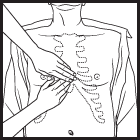heart is placed at the center but it is a bit tillted towards left and when the doctors give it a a hands press they do it on the center of the chest not on left
beatings are heard on the left bcoz it is almost located on the bottom tip of the heart but majority part of the heart is located at the center of the chest but slightly towards left side
Following is the exact medical defination
okay, lets consider that there are 5 regions in the chest (these are made up regions and are in noway, shape or form actually medical regions of the body) outer left, inner left, centre, inner right and outer right. Essentially, the regions that the heart takes up is the centre and inner left regions. So it is found in the centre, but skewed more to the left, and this is why the left lung is smaller then the right lung, because the heart, although in the centre, is taking up space towards the left.
EDIT: the reason why doctors listen to the heart in the lower left area of the chest is because that is wh
ere the heart is the most exposed and easiest to be heard, otherwise it's covered by the sternum, ribs and lungs. That most exposed area is where the apex (or point) of the heart is... Sooo if you maybe imagine a love heart (about the size of your fist) in the centre of the chest BUT the love heart is titled and the point on the bottom of the love heart is to the left, then that's kinda wat it's like.
he heart is situated in the mediastinum, which is a space between the lungs in the approximate center of your chest behind your breastbone. The heart is actually located more to the left, though, and so the reason you'll feel it beat harder on the left side is because that's where it is.
cardiopulmonary resuscitation.
it is also done by pressing the chest
here is the picture

Kneel by the victim's side and place the heel of one hand on the breast plate (midway between the nipples), locating the heel of your other hand on top of the first. Lock your elbows and press from your shoulders. Compress the chest with a continuous series of rapid compressions, about 100 per minute. Press down at least two inches, then fully release the chest. Repeat quickly. Continue until emergency help arrives.
the heel of the hand is always on the chest to thump it






























